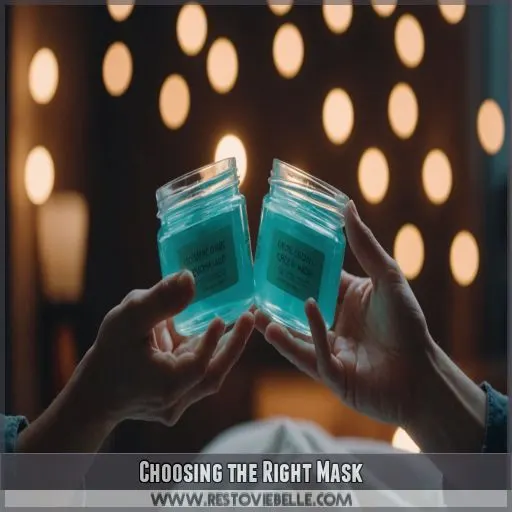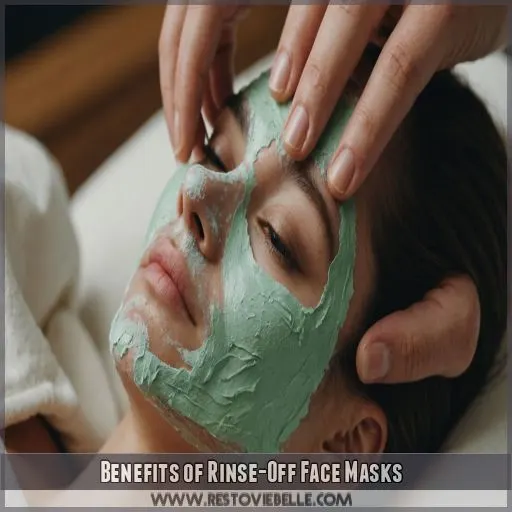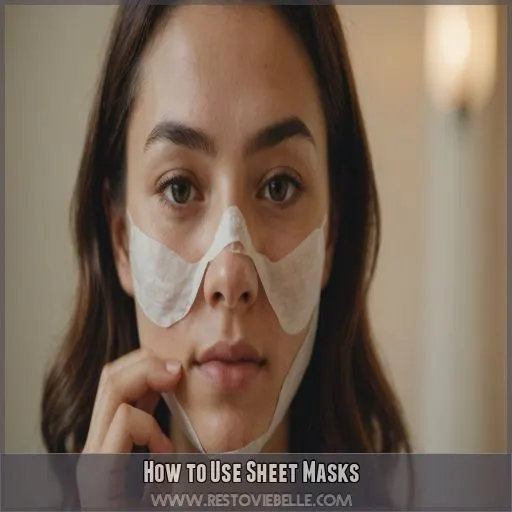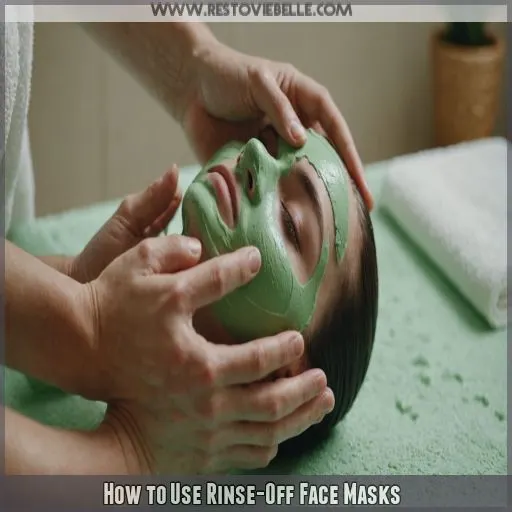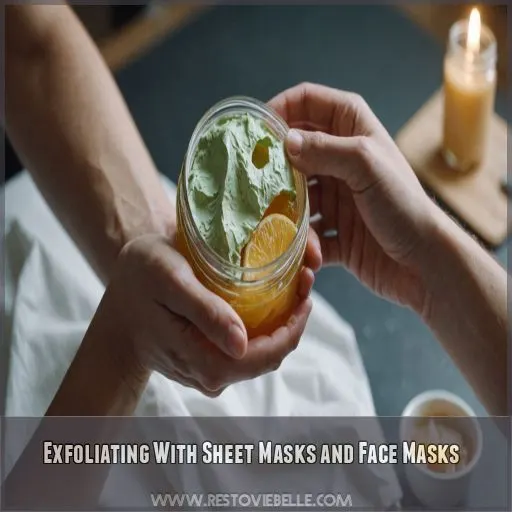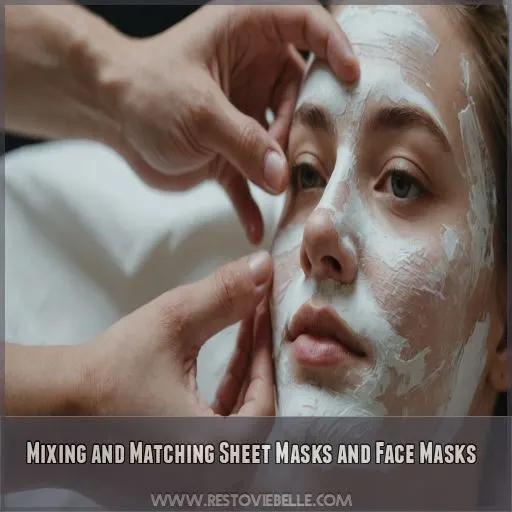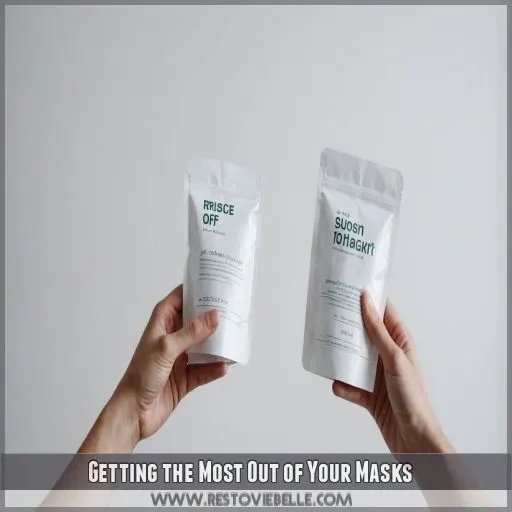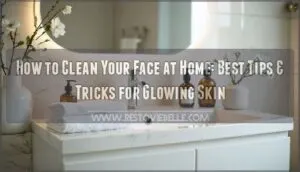This site is supported by our readers. We may earn a commission, at no cost to you, if you purchase through links.
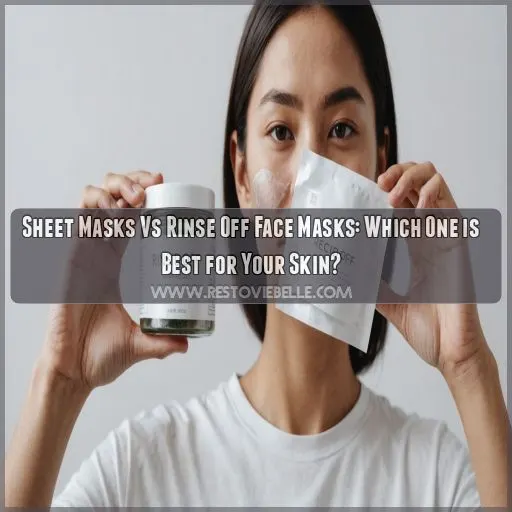 The age-old debate: sheet masks vs. rinse-off face masks! You’re probably wondering which one is best for your skin.
The age-old debate: sheet masks vs. rinse-off face masks! You’re probably wondering which one is best for your skin.
Well, let’s break it down. Sheet masks are like a quick drink of water for your skin – they provide instant hydration and can be used on-the-go.
Rinse-off masks, on the other hand, are like a deep cleanse for your pores – they draw out impurities and leave your skin feeling squeaky clean.
But here’s the thing: it’s not necessarily a one-or-the-other situation. By understanding your skin type and concerns, you can choose the right mask for the job and get the most out of your skincare routine.
Table Of Contents
- Key Takeaways
- Choosing the Right Mask
- Benefits of Sheet Masks
- Benefits of Rinse-Off Face Masks
- How to Use Sheet Masks
- How to Use Rinse-Off Face Masks
- Sheet Masks Vs Rinse-Off Face Masks
- Exfoliating With Sheet Masks and Face Masks
- Mixing and Matching Sheet Masks and Face Masks
- Getting the Most Out of Your Masks
- Frequently Asked Questions (FAQs)
- Are sheet masks better than wash off masks?
- Are sheet masks or peel off masks better?
- Which is better, sheet mask or face mask?
- Should you rinse your face after a sheet mask?
- Can I reuse sheet masks for better results ?
- Are sheet masks suitable for sensitive skin types ?
- How often should I use rinse-off face masks ?
- Can I leave sheet masks on for more than recommended ?
- Should I moisturize after using a rinse-off face mask ?
- Conclusion
Key Takeaways
- You don’t have to choose between sheet masks and rinse-off Face Masks – both can be your best friends! It’s all about understanding your skin type and concerns, so you can pick the right mask for the job and get the most out of your skincare routine.
- Sheet masks are like a quick drink of water for your skin – they provide instant hydration and can be used on the go. Look for ingredients like hyaluronic acid, ceramides, and glycerin to help lock in moisture and soothe dry, irritated skin.
- Rinse-off face masks, on the other hand, are like a deep cleanse for your pores – they draw out impurities and leave your skin feeling squeaky clean. Use them one to two times a week to exfoliate and remove dead skin cells, and don’t forget to moisturize after to keep your skin balanced and happy!
- Remember, it’s all about mixing and matching to find your perfect blend. Experiment with different masks, ingredients, and frequencies to create a customized skincare routine that tackles multiple skin concerns and leaves your skin looking and feeling its best. Happy masking!
Choosing the Right Mask
You’re on a mission to find the perfect mask for your skin, but with so many options out there, it can be overwhelming. To choose the right mask, start by figuring out your skin type and concerns – are you dry and dehydrated, oily, or super sensitive?
Determining Your Skin Type and Concerns
To pick the perfect mask, you need to know your skin type and concerns – take a skin type quiz to get started on your skincare routine!
Here are 4 common skin issues that require personalized mask choices:
- Dryness: Do you feel like the Sahara desert has taken over your face?
- Oiliness: Is your skin so oily that you could fry an egg on it?
- Acne: Are zits and pimples your arch-nemesis?
- Sensitivity: Does your skin freak out at the slightest touch?
Analyzing Ingredients for Specific Needs
When analyzing ingredients, consider your skin type and concerns. Look for ingredients that address your specific needs, and be aware of potential allergens or irritants.
Ingredients for Dry/Dehydrated Skin
If you have dry or dehydrated skin, don’t worry! You can look for ingredients like hyaluronic acid, ceramides, bamboo extract, and glycerin in sheet masks.
- Hyaluronic Acid: Attracts and retains moisture, giving your skin a plump and supple look.
- Ceramides: Restores the skin’s barrier function, locking in moisture and protecting it from environmental stressors.
- Bamboo Extract: Rich in antioxidants and has anti-inflammatory properties to soothe dry, irritated skin.
- Glycerin: Humectant that helps retain moisture in the skin, leaving it feeling soft and smooth.
Ingredients for Oily Skin
Got oily skin? Look for charcoal, salicylic acid, or clay masks to control acne and purify your pores. These ingredients will be your new BFFs!
Ingredients for Sensitive Skin
If you have sensitive skin, opt for gentle ingredients like centella asiatica, chamomile extract, or honey in your sheet masks or rinse-off face masks.
Benefits of Sheet Masks
If you’re looking for a quick way to give your skin some extra love, sheet masks are the way to go.
They’re like a quick pick-me-up for your face, delivering a powerful dose of hydration and nourishment.
With their ability to maximize ingredient absorption, sheet masks offer a range of benefits, from brightening and acne control to anti-aging, making them a great addition to your skincare routine.
Convenience and Hydration
You’re a busy bee, and sheet masks are your BFF for hydration and convenience! They’re perfect for a quick pick-me-up, and you can use them anywhere, anytime.
- Sheet mask hacks for the win: use them on-the-go or as an overnight treatment!
- Hydrating sheet masks are a must for dry, thirsty skin
- Overnight sheet masks: wake up to glowing, refreshed skin
- DIY sheet masks: get creative and make your own at home
Maximizing Ingredient Absorption
You want to get the most out of your sheet mask? Maximizing ingredient absorption is key! By trapping the serum, sheet masks help your skin soak up all the goodness.
| Mask Type | Material | Absorption Level |
|---|---|---|
| Sheet Mask | Hydrogel | High |
| Cream Mask | Cream | Medium |
| Rinse-Off Mask | Clay | Low |
Range of Benefits (Hydration, Brightening, Acne Control, Anti-Aging)
Now that you know how sheet masks maximize ingredient absorption, let’s talk about the amazing benefits they offer – from hydration and brightening to acne control and anti-aging. Here are three benefits:
- Hydration: Replenish your skin’s moisture levels and say goodbye to dryness and flakiness.
- Brightening: Get radiant, even-toned skin and reduce the appearance of dark spots and hyperpigmentation.
- Acne control: Tackle acne and prevent future breakouts with ingredients that soothe and calm your skin.
Common Ingredients (Vitamin B5, Agave Extracts, Jojoba Oil)
You’ll love the nourishing combo of Vitamin B5, agave extracts, and jojoba oil in sheet masks – they hydrate, soothe, and brighten your skin, making it look radiant and healthy.
Benefits of Rinse-Off Face Masks
You’re about to discover the amazing benefits of rinse-off face masks, which can give your skin a deep cleanse and purification like no other. By using rinse-off masks, you’ll be able to exfoliate and remove dead skin cells, control acne, and reduce pores, thanks to powerful ingredients like clay, charcoal, and salicylic acid.
Deep Cleansing and Purification
When you need a deep cleanse, turn to rinse-off face masks! Clay and charcoal masks are like a detox for your skin, drawing out impurities and purifying your pores for a fresh start.
Exfoliating and Removing Dead Skin Cells
Now that your skin is deeply cleansed, it’s time to exfoliate! Use rinse-off face masks 1-2 times a week to gently remove dead skin cells, revealing brighter, smoother skin without irritating it.
Controlling Acne and Reducing Pores
Now that you’ve exfoliated, it’s time to tackle acne and large pores. To win the battle, try incorporating acne-fighting ingredients and pore-minimizing routines into your mask game with these three tips:
- Get familiar with bentonite clay: This miracle worker absorbs excess oil and reduces inflammation.
- Exfoliate wisely: Balance physical and chemical exfoliants to avoid irritating your skin.
- Don’t overdo it: Find your perfect mask frequency to avoid clogging pores.
Common Ingredients (Clay, Charcoal, Salicylic Acid)
You’ll love the detoxifying powers of clay, charcoal, and salicylic acid in rinse-off masks! These natural ingredients unclog pores, reduce acne, and leave your skin feeling refreshed and revitalized, without stripping its natural oils.
How to Use Sheet Masks
You’re about to discover the secret to glowing skin with sheet masks – and the best part is, it’s ridiculously easy! To get started, let’s walk through the simple steps of using a sheet mask, from prepping your face to maximizing that wonderful, gooey essence.
Preparing Your Face for a Sheet Mask
To get the most out of your sheet mask, start by prepping your face. Here are some quick tips:
- Cleanse your skin to remove dirt and makeup
- Exfoliate to unclog pores and boost absorption
- Tone to balance your skin’s pH
- Moisturize to hydrate and soften
- Apply serums to target specific skin concerns
Applying and Adjusting the Mask
Now that your face is prepped, it’s time to apply the sheet mask! Place it over your face, adjusting the eye cutouts, nose bridge, and chin to make sure it fits snugly and comfortably.
Leaving the Mask on and Patting in Leftover Essence
Now that you’ve got your sheet mask on, relax for 20-30 minutes. When it’s time to remove, gently pat in any leftover essence – don’t waste a drop of that good stuff!
- Leave the mask on for the recommended time to maximize essence absorption.
- Remove the mask and discard it – don’t reuse, darling!
- Gently pat the leftover essence into your skin with your fingertips.
- Don’t rub or scrub, you’re not trying to remove last night’s makeup.
- Let the essence benefits soak in and get ready to glow!
Tips for Maximum Absorption
To maximize absorption, gently massage the essence into your skin, then let it sit for a few minutes. Try using your sheet mask in a warm room to open up those pores!
How to Use Rinse-Off Face Masks
You’re ready to give rinse-off face masks a try, but you’re not sure where to start – don’t worry, using them is a breeze. Just follow a few simple steps, and you’ll be on your way to glowing, healthy-looking skin in no time.
Preparing Your Face for a Rinse-Off Mask
Before applying a rinse-off mask, get your face ready! Cleanse your skin thoroughly, wipe it dry, and prime it with toner. Now you’re all set for a deep cleansing experience!
Here are the steps to prepare your face:
- Cleanse your skin: Wash your face with a gentle cleanser to remove dirt and impurities.
- Wipe dry: Gently pat your face dry with a towel to remove excess moisture.
- Prime with toner: Apply a toner to balance your skin’s pH and prepare it for the mask.
- Remove any makeup: Make sure to remove all makeup and sunscreen before applying the mask.
Applying and Spreading the Mask
Now it’s time to get your mask on – literally! Use a brush or your fingertips to apply the mask, spreading it evenly from your neck up to your face.
| Mask Application Techniques | Benefits |
|---|---|
| Brush | Precise application, even coverage |
| Fingertips | Gentle, soothing, and relaxing |
| Mask applicator | Easy to use, less mess |
| Konjac sponge | Exfoliates and smooths skin |
Leaving the Mask on and Washing Off
Now that you’ve applied the mask, let it sit for 15-20 minutes. Here are three things to keep in mind:
- Don’t overdo it: Avoid leaving the mask on for too long, as this can cause dryness.
- Rinse thoroughly: Use lukewarm water to rinse off the mask, making sure to remove all residue.
- Pat dry: Gently pat your face dry with a towel to prevent irritation.
Tips for Gentle Exfoliation
When washing off your rinse-off mask, gently massage your skin in circular motions to exfoliate. Be gentle, especially if you have sensitive skin. Here’s a quick guide to get you started:
| Exfoliating Tools | Frequency | Tips for Sensitive Skin |
|---|---|---|
| Soft washcloths | 1-2 times a week | Start slow, be gentle |
| DIY sugar scrubs | 1 time a week | Mix with gentle ingredients |
| Chemical exfoliants | As directed | Patch test, start low |
Sheet Masks Vs Rinse-Off Face Masks

You’re probably wondering which type of mask is best for your skin – sheet masks or rinse-off face masks? Let’s break down the key differences between these two popular options to help you decide which one will give your skin the TLC it needs.
Convenience and Time Commitment
If you’re looking for convenience and less time commitment, sheet masks are the clear winner – just slap one on and chill for 20 minutes, whereas rinse-off masks require a bit more effort.
Hydration and Moisturization
For hydration, sheet masks are the clear winner, providing an intense dose of moisture to dry skin, while rinse-off masks can sometimes strip your skin of its natural oils.
Exfoliation and Deep Cleansing
Now that we’ve talked hydration, let’s get down to business – exfoliation and deep cleansing. Here’s how sheet masks and rinse-off face masks compare:
- Exfoliation frequency: how often is too often?
- Scrub vs mask: which is better for your skin?
- DIY masks: can they replace at-home microdermabrasion?
- Cleansing routine: where do masks fit in?
Skin Type and Concerns
If you’re trying to choose between sheet masks and rinse-off face masks, it really depends on your skin type and what you’re hoping to achieve. Here’s a breakdown to help you decide:
| Skin Type | Sheet Masks | Rinse-Off Face Masks |
|---|---|---|
| Sensitive | Soothing and hydrating | Gentle, fragrance-free options |
| Acne-prone | Salicylic acid and tea tree oil | Clay and charcoal for detoxifying |
| Dry/Dehydrated | Hyaluronic acid and ceramides | Moisturizing and nourishing ingredients |
| Oily | Oil-controlling and balancing | Clay and charcoal for purifying |
Exfoliating With Sheet Masks and Face Masks
If you’re looking for ways to exfoliate, you’ve got two great options: sheet masks and rinse-off face masks, both of which can help remove dead skin cells and unclog pores. In this section, we’ll explore how to harness the exfoliating power of both types of masks to reveal brighter, smoother skin that’s sure to turn heads!
Physical Exfoliants (Alpha-Hydroxy Acids, Beta-Hydroxy Acids)
If you’re thinking about using physical exfoliants, you’ve got two popular options: Alpha-Hydroxy Acids (AHAs) and Beta-Hydroxy Acids (BHAs). AHAs are great for surface-level exfoliation, while BHAs penetrate deeper to unclog pores. Use them 1-3 times a week, depending on your skin sensitivity.
Chemical Exfoliants (Enzyme Exfoliants, Glycolic Acid)
Now that you know about physical exfoliants, let’s talk chemical exfoliants! Enzyme exfoliants and glycolic acid are great options. Glycolic acid helps break down dead skin cells, while enzyme exfoliants like papain and bromelain dissolve proteins, making it easy to slough off dead skin.
Benefits of Exfoliating (Brightening, Smoothing, Unclogging Pores)
Exfoliating is like a mini-vacation for your skin! It brightens and smooths your complexion, unclogs pores, and leaves you with a radiant glow. Regular exfoliation also helps even out skin tone and texture, giving you a more confident, fresh-faced look.
Mixing and Matching Sheet Masks and Face Masks
You’re probably thinking, "Why choose just one type of mask when I can mix and match for even better results?" By combining sheet masks and rinse-off face masks, you can create a customized skincare routine that tackles multiple skin concerns and leaves your skin looking and feeling its best.
Combining Masks for Customized Benefits
Now that you know the benefits of exfoliating with sheet masks and face masks, let’s mix things up! By combining masks, you can create customized benefits that fit your skin type and concerns. Here are some ideas to get you started:
- Try sheet mask layering by applying a hydrating sheet mask followed by a brightening one.
- Experiment with DIY mask blends by mixing a clay mask with a few drops of your favorite essential oil.
- Play with frequency and timing by using a sheet mask in the morning and a rinse-off mask at night.
Alternating Between Sheet Masks and Face Masks
Ready to mix it up? Alternating between sheet masks and face masks can be a game-changer for your skin. Consider your skin type and concerns, and switch up your routine to maximize benefits. Your skin (and wallet) will thank you!
Using Masks in Conjunction With Other Skincare Products
Now that you’re alternating between sheet masks and face masks, let’s talk about using them with other skincare products. Think of sheet mask layering, serum timing, and mask frequency as a recipe for glowing skin – mix and match to find your perfect blend!
Getting the Most Out of Your Masks
You’ve invested in a stash of sheet masks and rinse-off face masks, but now it’s time to get the most out of them. To maximize their benefits, you’ll want to learn how to use them correctly, how often to use them, and how to store them to keep them fresh and effective.
Tips for Maximizing Absorption and Benefits
To maximize absorption and benefits, store your masks in a cool, dry place. Timing matters, so apply masks when your skin is most receptive. Layering products can boost results. Make sure your skin is clean and use a gentle patting technique to help the mask absorb better.
How Often to Use Masks for Optimal Results
Now that you’re maximizing absorption, let’s talk frequency! For the best results, use sheet masks 1-3 times a week, depending on your skin type and concerns. Track your results and adjust accordingly – over-masking can lead to clogged pores and diminishing returns.
Storing and Handling Masks for Long-Lasting Use
To get the most out of your masks, store them in a cool, dry place, away from direct sunlight. Check expiration dates and follow proper handling tips to maintain mask hygiene. This will help your masks stay effective and fresh for a longer shelf life.
Frequently Asked Questions (FAQs)
Are sheet masks better than wash off masks?
You’re in control! Both sheet masks and wash-off masks have their perks. Sheet masks offer hydration and convenience, while wash-off masks provide a deep cleanse. Choose what your skin craves, and let the pampering begin!
Are sheet masks or peel off masks better?
Choosing between sheet masks and peel-off masks? Sheet masks offer hydration and convenience, while peel-off masks can provide a deeper cleanse and exfoliation. Consider your skin type and needs to decide which one works best for you!
Which is better, sheet mask or face mask?
Hey, which is better for you – a sheet mask or a face mask? Honestly, it depends on your skin type and needs! Sheet masks are great for hydration, while face masks can offer a deeper cleanse.
Should you rinse your face after a sheet mask?
Don’t rinse off the goodness just yet! After a sheet mask, gently pat any leftover essence into your skin to maximize absorption, and let your skin drink it in – no rinsing required, just glow!
Can I reuse sheet masks for better results ?
Sorry, buddy! Reusing sheet masks isn’t the way to go. Their effectiveness comes from the concentrated serum, which gets depleted after one use. Using it again won’t give you better results, just less potent benefits.
Are sheet masks suitable for sensitive skin types ?
You’ve got sensitive skin, don’t worry! Sheet masks can be your BFF, but choose wisely. Opt for ingredients like panthenol, centella asiatica, or chamomile extract, which are gentle and soothing. Your skin will thank you!
How often should I use rinse-off face masks ?
Moderation is key!" Using rinse-off face masks one to two times a week is ideal, allowing your skin to reap the benefits without over-exfoliating or stripping it of its natural oils, keeping it balanced and healthy.
Can I leave sheet masks on for more than recommended ?
Don’t overdo it! Leaving sheet masks on for too long can cause irritation or dryness. Stick to the recommended 20-30 minutes to reap the benefits without any negative side effects.
Should I moisturize after using a rinse-off face mask ?
Hey, don’t skip moisturizing after a rinse-off face mask! You’ve just deep cleaned your pores, so lock in that cleanliness with a hydrating moisturizer to keep your skin balanced and happy – it’s the perfect finishing touch!
Conclusion
Think of the age-old debate between sheet masks vs rinse-off face masks as a myth-busting mission.
You’ve probably heard that one is inherently better than the other, but the truth is, it’s all about your skin type and concerns.
By understanding what your skin needs, you can choose the right mask for the job and get the most out of your skincare routine.
Experiment with both and find your perfect match; your skin will thank you!

